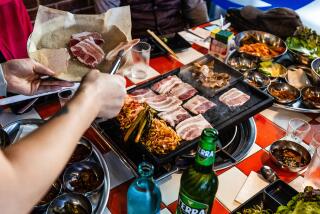Recipe: Pan-fried pork and scallion mini buns (Sheng jian bao zi)

Pan-fried pork and scallion mini buns (Sheng jian baozi)Total Time: 45 minutes plus rising timeServings: Makes 32 mini bunsNote: You can find ground pork with a higher fat content at many Asian markets, or ask your butcher to grind fat into regular ground pork (you want about 20% fat). Or substitute regular ground pork. Ground beef chuck or chicken thigh may be substituted for the pork in this recipe. Regardless, fatty, rich ground meat makes for better, succulent buns. Shaoxing rice wine and Chinkiang vinegar are available at Chinese and most Asian markets. Recipe by Andrea Nguyen.10 ounces fatty ground pork, coarsely chopped to loosen2 teaspoons minced fresh ginger 1/4 cup finely chopped Chinese chives or scallions (white and green parts) 1/4 teaspoon plus 1/8 teaspoon salt 1/8 teaspoon white pepper 1/2 teaspoon sugar1 tablespoon light (regular) soy sauce, plus additional (optional) for dipping2 teaspoons Shaoxing rice wine or dry sherry2 teaspoons sesame oil1 tablespoon water1 1/4 pounds basic yeast dough (recipe above), preferably made with unbleached flour1 tablespoon finely julienned fresh ginger 1/4 cup Chinkiang vinegar or balsamic vinegar Chile oil, optionalCanola oil1. To make the filling, combine the pork, minced ginger and Chinese chives in a medium bowl. Use a fork or spatula to stir and lightly mash the ingredients together.2. In a small bowl, combine the salt, white pepper, sugar, soy sauce, rice wine, sesame oil and water and stir to combine well. Pour over the meat mixture, then vigorously stir to fully incorporate. Cover the filling with plastic wrap and set aside for 30 minutes, or refrigerate overnight, returning it to room temperature before assembling the buns.3. Transfer the dough to a very lightly floured work surface, gather it into a ball if needed, and then pat it to flatten it into a thick disk. Cut the disk in half and cover half with plastic wrap or an inverted bowl to prevent drying while you work on the other half. (If your kitchen is very warm or the dough rises quickly, refrigerate the remaining half while you work on the first half.)4. Roll the dough half into a 12- to 14-inch log, then cut it crosswise into 16 pieces. (Halve the log first to make it easier to cut into even-size pieces. The tapered end pieces should be cut a little longer than the rest.) Lightly roll each piece between your hands into a ball and then use the palm of one hand to flatten it into a one-fourth-inch-thick disk, moistening your hands with a little water if the dough becomes too dry.5. Use an Asian dowel-style rolling pin to roll the pieces into circles about 2 1/2 inches in diameter, rolling the outer one-half-inch edge of the circle very thin, like a tortilla (the center of the circle -- about 1 inch -- will remain thicker). Rotate the circle as you roll the outer edge with the pin to form a perfect circle. Alternatively, you can press out the circles by hand, using your fingers to flatten the center and edges, though the circles may not be as perfect. The finished circle will be thick, and it will rise as it sits. Lay the finished circles out on your work surface, lightly dusting their bottoms with flour if you fear they will stick.6. Line a baking sheet with parchment paper and lightly dust with flour. To assemble the buns, hold a dough circle in a slightly cupped hand. Use a bamboo spatula, dinner knife or spoon to center about 2 teaspoons of filling on the dough circle, pressing down very gently and keeping about one-half to three-fourths inch of the dough clear on all sides; your hand will automatically close slightly. Use the thumb of the hand cradling the bun to push down the filling while the fingers of the other hand pulls up the dough edge and pleats and pinches the rim together to form a closed satchel. Completely enclose the filling by pinching and twisting the dough closed. Place the finished bun, pleated side down, on the prepared baking sheet. Repeat with the remaining dough circles and filling. Loosely cover the buns with plastic wrap and set aside until almost doubled in size, 10 to 30 minutes, depending on the temperature of the room.7. While the buns rise, divide the julienned ginger and vinegar between 2 communal bowls. Taste and, if the vinegar is too tart, add water by the teaspoon. Set them at the table along with the soy sauce and chile oil for guests to mix their own sauce.8. To pan-fry the buns, use a medium or large nonstick skillet. Heat the skillet(s) over medium heat and add 1 tablespoon of canola oil for a medium skillet and 1 1/2 tablespoons for a large one. Add the buns 1 at a time, arranging them, pleated side up, a half-inch apart; they will expand during cooking. The buns will need to be cooked in batches. (In general, medium skillets will fit 8 or 9 buns; large skillets will fit 12 or 13 buns.) Fry the buns for 1 to 2 minutes, or until they are golden or light brown on the bottom. Use your fingers to gently lift them to check the color.9. Holding the lid close to the skillet to lessen the spattering effect of water hitting hot oil, carefully add enough water to come up the side of the buns by one-fourth inch, about one-fourth cup. The water and oil will sputter a bit. Cover with a lid or aluminum foil, placing it very slightly ajar to allow steam to escape, so condensation doesn’t fall on the buns and perhaps cause their collapse. Let the water bubble away until it is mostly gone, about 6 minutes.10. When you hear sizzling noises (a sign that most of the water is gone), remove the lid. Let the dumplings fry, uncovered, for about 1 minute, until the bottoms are brown and crisp. At this point, you can serve the buns, crisp bottoms up, like pot stickers. Or you can use chopsticks to flip each bun over (separate any that are sticking together first) and then fry the other side for about 45 seconds, until golden.11. Remove from heat and wait for the cooking action to cease, then transfer the buns to a serving plate. Display them golden side up. Serve with the gingered vinegar, chile oil and soy sauce. Eat these buns with chopsticks -- they’re a little greasy on the fingers. Leftover buns can be refrigerated and reheated with a touch of oil and a bit of water in a nonstick skillet.Each mini bun: 92 calories; 3 grams protein; 10 grams carbohydrates; 0 fiber; 4 grams fat; 1 gram saturated fat; 6 mg. cholesterol; 92 mg. sodium.
More to Read
Eat your way across L.A.
Get our weekly Tasting Notes newsletter for reviews, news and more.
You may occasionally receive promotional content from the Los Angeles Times.






